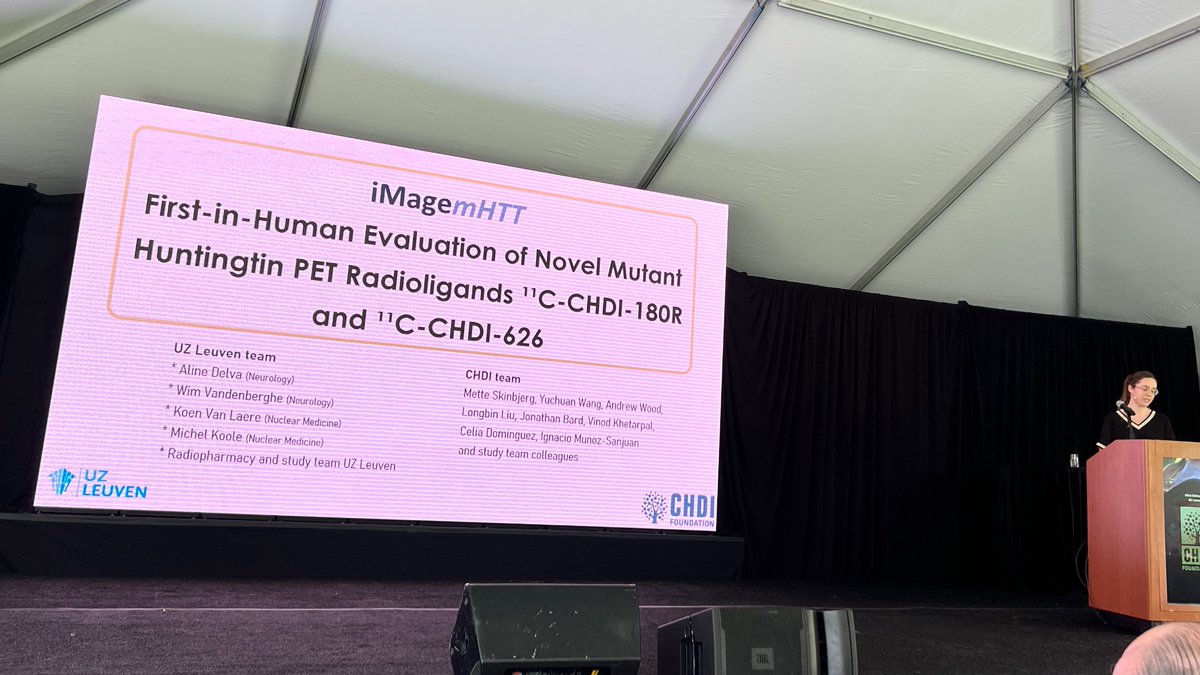Good morning! Today is the 3rd and final day of the #CHDI HD Therapeutics Conference in Palm Springs. Follow our feed today to get live updates! #HDTC2022
The fourth session of research talks will cover biomarkers and clinical tools for diagnosing, tracking, and treating HD. It is being introduced by Dr. Edith Monteagudo of CHDI and Dr. Niels Skotte, of University of Copenhagen. #HDTC2022
The first talk is by Dr. Cristina Sampaio & Dr. Robert E Pacifici, both from CHDI. They’ll be discussing CHDI’s Biomarker Task Force, focused on developing a strategy for moving biomarkers for HD forward. #HDTC2022
Biomarkers are critical for drug development. They allow researchers to track disease progession. They’ll also be critical as the field moves forward with treatments, because they’ll allow researchers to determine if patients are getting better. #HDTC2022
CHDI and other organizations are committed to making biomarker data (and many other types of data) available in a way that can benefit the entire HD research and family community, not just an individual company. #HDTC2022
CHDI is focused on advancing biomarkers related to imaging (such as MRI scans), blood, and spinal fluid. #HDTC2022
One molecule that didn’t turn out to be a great biomarker in blood is expanded huntingtin. Even though it’s directly involved in causing HD, it turns out it doesn’t track well with disease progression. #HDTC2022
It seems like imaging is a strong bet in the biomarker field. Identifying biomarkers that can be assessed using imaging would give researchers a non-invasive way to continually track HD patients over time. #HDTC2022
Another key component of defining biomarkers is to find those that change with very early HD progression. This will allow researchers to start monitoring disease at the very earliest stages, before symptoms appear - a time when some think treatment needs to begin. #HDTC2022
The lengthening of CAG repeats in some cells over time, known as somatic repeat expansion, is not only gaining interest because of the effects it has on age of disease onset, but it may also be useful as a biomarker. #HDTC2022
There are also ways to take advantage of “wearables” - digital devices, like watches, that people with HD can wear to gather lots of data in real time. These devices could track movement, sleep habits, and other metrics. #HDTC2022
CHDI has a 2-year goal for defining some of these important biomarkers and is eager to collaborate with the entire HD research community for this important project. #HDTC2022
The next speaker is Dr. Jim Rosinski from CHDI. He’ll be sharing his work using large datasets that will help profile people with HD for biomarker discovery. He feels “the future is bright!” #HDTC2022
We& #39;re in a new age of data where scientists are able to measure thousands of changes in genetic messages and protein over time in many individuals. Using powerful analysis techniques, sorting through this data can be very valuable for drug development. #HDTC2022
Doing this requires a strong “pipeline,” from being able to collect blood and spinal fluid samples from many people with HD, to developing the skills and software to understand the data. This is where observational studies like Enroll-HD and HDClarity come into play. #HDTC2022
Samples donated by HD families who participate in these studies are essential for the many different types of analyses that can be made, by looking at how genes turn on and off, and examining changes in levels of different forms of RNA and protein. #HDTC2022
Looking at changes in protein levels across a brain area, organism, or group of people with a disease is known as proteomics. Using spinal fluid samples donated through the HDClarity study, researchers can link clinical data from Enroll HD with protein changes. #HDTC2022
Dr. Rosinski shared some exciting preliminary data tracking many proteins in a large group of HDClarity participants. Looking at each individual protein alongside clinical data will help define biomarkers for disease progression and identify routes for drug design. #HDTC2022
One biomarker that’s been defined in HD is neurofilament light - NfL. It turns out, it’s a really great biomarker! Dr. Rosinski found that just looking at this one protein can predict HD status! Wow! #HDTC2022
They also identified a few other proteins that are predictive of where a person might be in their HD symptoms. Ultimately, combining these findings could power more individualized care and treatment in HD. #HDTC2022
The future is bright! Instead of scientists talking about IF we’ll have a treatment for HD, they’re focused on WHEN we get a treatment, we need biomarkers that will help us track how patients are doing. We’ve come a long way! #HDTC2022
Next up is Dr. Aline Delva from KU Leuven. Dr. Delva will be describing her work using a type of imaging called PET. We recenlty wrote about it here: https://en.hdbuzz.net/319 ">https://en.hdbuzz.net/319"... #HDTC2022
PET ligands allow scientists and clinicians to visualize things inside the body or brain. This particular ligand is designed to stick to huntingtin and make it light up in a brain scanner, so levels can be tracked over time, and eventually during treatment. #HDTC2022
Dr. Delva is sharing new data from a human study where the PET ligand sticks to synapses, connection points between brain cells, to track their health over time, especially in areas of the brain that are most vulnerable to HD. #HDTC2022
It appears that these PET ligands can detect changes even in premanifest HD patients! This is great news because it gives researchers a tool to determine if a treatment is making a patient better before there are even noticeable HD-related changes. #HDTC2022

 Read on Twitter
Read on Twitter


